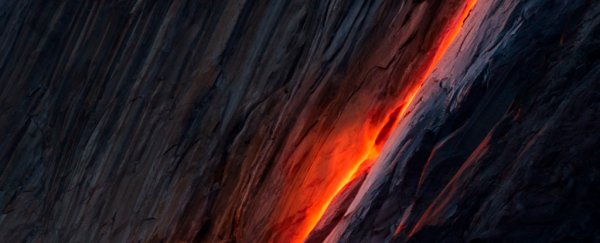From December to April in Yosemite National Park, chilly water from melting mountain snow streams toward the eastern edge of El Capitan and forms what's known as Horsetail Falls.
The cascade is predictably picturesque within the greater grandeur of one of the country's most stunning national parks. But it becomes truly phenomenal for just a few days in February, when a trick of the light transforms the falling water into a flow of illusory lava.
The annual "firefall" effect, as it is called, is happening now at Yosemite and will probably last only through this upcoming weekend, when the tilt of the Earth will shift and disrupt the delicate balance of factors that creates the fiery specter.
View this post on Instagram
The annual occurrence draws nature fiends and photographers from around the globe into the cold for an opportunity to glimpse the mesmerizing, red-orange glow. The "firefall" phenomenon generally lasts seven to 10 days in late February - but the show is never guaranteed.
"There's always a lot of different factors," said park ranger and public affairs officer Scott Gediman, who has worked at Yosemite for 23 years and witnessed countless "firefalls" there. "It's a hit-and-miss kind of thing."
View this post on Instagram
For the "firefall" to work, numerous natural occurrences have to sync up. There must be snow in Yosemite, and the temperature must be warm enough to melt that snow and create the waterfall, Gediman said.
When California experiences drought, the waterfalls don't flow, and Horsetail can't glow.
This week, there has been plenty of snowfall to feed the cascade, but even that isn't enough to guarantee a full "firefall" at sunset. Also needed is a cloudless sky - even the slightest haze can diminish the spectacle.
View this post on Instagram
And finally, the setting sun must align just so with the falls, so that as it dips toward the horizon, its warm glow is reflected onto the running water and projected to our eyes as lava-like.
"The angle of the sun is really what's the key to it," Gediman said, similar to the way a brilliant blue sky reflecting on a lake can make it appear brilliant blue, too, or a tropical sunrise can cast a pink-purple sheen upon the shoreline.
Even when all those conditions are just right - the snow, the sun, the sky - the evening "firefalls" at Horsetail Falls last no more than 10 minutes. Because of snowfall or dangerous weather, it can at times be difficult to access the falls in the narrow time frame nature allots for its grand show.
But when visitors choose to make the journey, Gediman said, they are rarely disappointed.
View this post on Instagram
"It's a really fun atmosphere," he said. "It's a challenge. People walk out there, they get their spot, they hope it happens."
On Tuesday night, Gediman said, he accompanied a local TV news crew to a lookout spot alongside some of the estimated 400 people who had also turned up to watch. There were visitors from England, India and Argentina. Some came as early as 8 am to stake out their perch.
People swapped camera lens information in anticipation of the glow.
"For me, as a longtime national park ranger, I just thought to myself: 'This is cool,' " he said. "It's special."
The naturally occurring "firefall" has been compared to a man-made one that was once a staple experience at Yosemite long before it become a national park.
From atop another high perch in the valley, Glacier Point, visitors could sit around a large, roaring campfire until evening fell.
Then, at 9 pm every night, a "fire caller" in the village of Curry far below would shout up to the those atop Glacier point, and they would shout back.
The fire caller would yell "let the fire fall," and the glowing embers from the campfire would be thrown from the cliff's edge. But in 1968, after nearly a century of the ritual, the National Park Service banned the man-made firefall.
View this post on Instagram
Today, with the help of social media's popularizing ways, Yosemite visitors are instead delighted by the naturally occurring "firefall" that visits Horsetail Falls each winter - given all the right circumstances.
"That's what it's all about," Gediman said.
2019 © The Washington Post
This article was originally published by The Washington Post.
